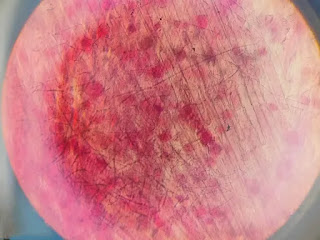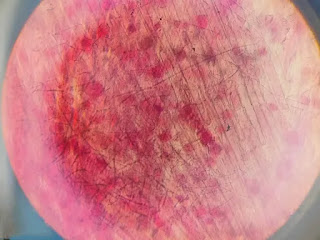Hello Everyone in this article we will discuss about DNA by Feulgen Reaction Practical in detail.
DNA by Feulgen Reaction Practical
Aim of this Experiment –
To stain nuclear DNA in Eukaryotic cells with Feulgen (we will use Onion root tip as the source of eukaryotic cell here)
Materials Required –
- Onion Root
- Formaldehyde
- 1N HCl
- Schiff’s reagent
- Acetocarmine
- Distilled water
Other Equipments –
- Glass slide & cover slip
- Watch glass
- Dropper
- Forceps
- Blotting paper
Procedure of DNA Feulgen Practical –
- Fresh onion roots were collected and transferred to a watch glass containing distilled water for 5 minutes.
- With the help of forceps, the root tip was was placed on glass slide, followed by fixation with Formaldehyde for 5 minutes.
- The fixed material was treated with 1N HCl for 8-12 minutes in a water bath at 60⁰C.
- Afterwards the root was placed into Schiff’s reagent at room temperature for 30 minutes.
- The root was rinsed in water for 5 minutes, followed by addition of Acetocarmine.
- Lastly the root was rinsed in water again and blotted dry.
- Finally the root was covered with cover slip and slightly pressed.
- The slide is observed under 40X magnification in compound Microscope.
Principle of DNA by Feulgen Reaction Practical –
The Feulgen stain was invented by German Physician Robert Feulgen during 1914-1924.
He estimated the nature of Neuclic acid as polymer of nucleotide with four kinds of Nitrogenous bases. It is probably the most simple cytochemical method allowing indication and evaluation of DNA levels into the cell.
Feulgen reaction consists of two steps –
- Initially Acid Hydrolysis is performed for 8-12 minutes, resulting in the cleavage of Nitrogen bases from deoxy ribose and formation of free Aldehyde groups.
- Then the preparation is placed in light Yellow Schiff’s Reagent, which forms bond with this groups (Free aldehyde). The red violet product form in this step is evidence of presence of DNA. RNA is not hydrolysed by the HCl treatment and thus this reaction is DNA specific.
The pink colour intensity correlates with DNA content in the Cell. However Feulgen technique is semiconservative in nature. It is becoming quantitative for DNA , if the only aldehyde are remaining in the cell are those produced by Hydrolysis of DNA.
As DNA from any of organisms has the same nature, we can use cells form any source (Human , animal or plant) to demonstrate the presence of Nucleus. We used onion roots to perform this experiment.
Result of DNA Feulgen Experiment –
when the slide was visualised under the microscope, some Dark coloured along with some Light coloured regions were seen. Dark colour region indicates the Nucleus as it is present in the centre of the cell. While the rest of the light stained region indicates Cell Cytoplasm as it surrounds the Nucleus.
In proper colour –
- Nucleus – Dark Pink Colour
- Cytoplasm – Magenta Colour.
FAQ Related to Feulgen Reaction Practical
Why temperature is required in Feulgen staining?
60⁰ C temperature is required for acid Hydrolysis of DNA . It’s performed usually for 8-12 minutes, resulting in cleavage of Nitrogen bases from Deoxy ribose and the formation of free Aldehyde groups.
Colour of Nucleus in Feulgen reaction?
Nucleus is observed as Dark Pink colour in Feulgen method.
What is indicated by Magenta Colour in Feulgen reaction?
Cytoplasm is coloured Magenta coloured in DNA by Feulgen reaction.
Role of HCL in acetocarmine staining in onion root tip ?
RNA is not Hydrolysed by the HCl treatment and thus this reaction is DNA specific.
Conclusion –
I hope this article helped to know you about Feulgen Reaction Experiment or DNA by Feulgen reaction Practical. If you still have any doubts don’t forget to comment it.
Thanks for visiting us.



